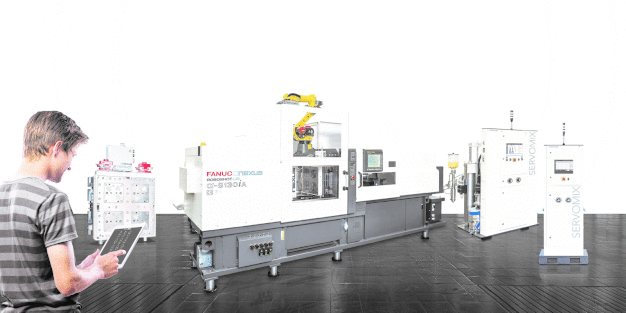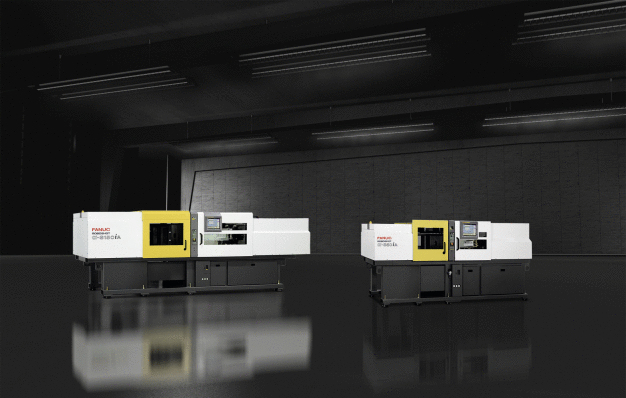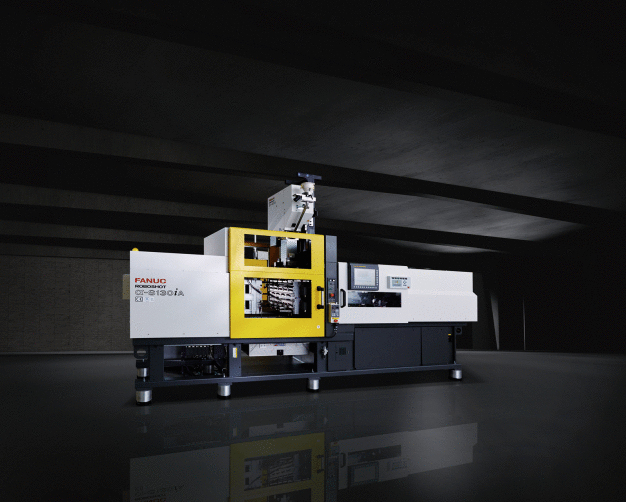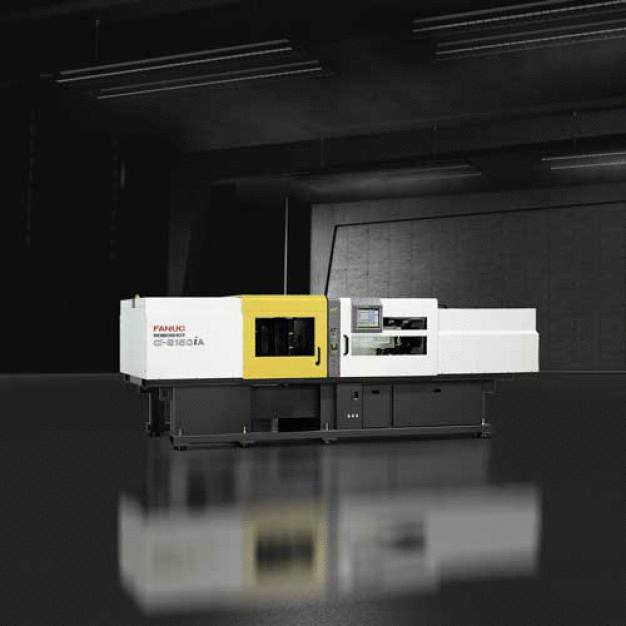FANUC at FAKUMA 2017 in Friedrichshafen, Germany
Two-component technology and automated production cell with sustainable injection moulding performance – always all-electric
In recent years, injection moulders have clearly shown an increasing interest in all-electric injection moulding machines with particularly economic energy balance as well as in fully automatic production systems. FANUC will exhibit three of its all-electric ROBOSHOT injection moulding machines at FAKUMA 2017 in Hall B3 on Stand 3211, which will take users’ current requirements seamlessly into consideration.
LIVE demonstrations
A 150-ton ROBOSHOT Alpha-S150iA in a fully automatic production cell shows precision parts with light conductor in a two-component injection moulding process. Visitors can also get information regarding economic production of moulded parts in LSR on a 130-ton version supported by an M-10iA – M-20iA FANUC robot. The third exhibit, a 30-ton ROBOSHOT Alpha-S30iA with a M-1iA robot, produces Smartphone precision connectors in LCP in a highly economically way.
“With three specific applications, we will show a cross-section of the FANUC ROBOSHOT performance in cooperation with renowned systems partners….”, explains Wolfgang Haak, production manager ROBOSHOT, and elaborates “…with energy recovery control, consistent repeatability, precision and process security and torque-dependent dosing control – PMC2 and PMC3 – with a specific backflow monitor and the efficient AI mould protection. Last, but not least, we will demonstrate our economic and technological competence, in conjunction with our systems partners, in the sectors two-component injection moulding and production cells with high flexibility.”
Production cell for two-component applications
On a FANUC ROBOSHOT Alpha-S 150iA with vertical SI-20iA injection unit – integrated in a Robotech Plastic-Mate production cell – automotive parts with light conductor are produced in Macrolon PC in a Weber two-cavity turntable mould. Part removal is carried out by a FANUC LR-Mate 6-axis industrial robot, combined with a linear axis as well as an iRVision integrated visual control station. The result is 100 percent assured double-sided part control, consistent component weight and a total cycle time of only 57 seconds.
Cooperation between FANUC and NEXUS
A highlight is the turnkey system with a Nexus ROBOSHOT LSR, bringing premium performance to elastomer injection moulding. The associated injection mould, made in the in-house tool shop, with TIMESHOT cold-runner control is supplemented by the integration of two SERVOMIX dosing systems with unique SPLITNEX technology and the new NANOSHOREMIX LSR application (NEXUS SERVOMIX E200 Premium Edition + NEXUS SERVOMIX E20 Eco). Demonstrated is the production of a component in Elastosil 3066/60 liquid silicon by Wacker.
System Components:
- FANUC NEXUS ROBOSHOT LSR injection moulding machine Alpha-S 130iA
- FANUC robot M-10 – M-12
- NEXUS LSR NANOSHOREMIX (dosing system SERVOMIX E200 Premium Edition + LSR dosing system SERVOMIX E20 Eco)
- NEXUS LSR 16-cavity injection mould with TIMESHOT valve gate cold-runner system
- Packing and printing including conveyor belt
FANUC ROBOSHOT ALPHA-S 30iA producing precision connectors – four parts every two seconds Produced are LCP Smartphone precision connectors in a four-cavity mould supplied by SAYAMA. Those products must meet the strictest quality standards. Consequently, these parameters require very high process stability and reliability of the machine. The all-electric FANUC ROBOSHOT fully complies with these conditions providing innovative unique servo control functions. Cavity-dependent component sorting is enabled via the M-1iA robot, equipped with iRVision for optical recognition. The state-of the-art high precision miniature connector boasts a pitch of merely 0.35mm – with a precision factor within the µ range. With less than 2 seconds, the cycle time is remarkably short.
Energy regeneration – with emphasis on profit
The feature of energy recovery – whereby the servo-drive motors in the ROBOSHOT machines generate electrical energy as they decelerate, when closing and opening the mould after locking – contributes a tremendous potential for reducing energy costs. “We utilise kinematic and turn it into regenerated power instead of discharging thermal energy into the air,” says Wolfgang Haak, and adds that “the amount of energy produced in this way depends on the machine and process, but it amounts to around 5 percent of power saved on average, on top of the 40-60 percent lower energy consumption of all-electric machines as opposed to hydraulic ones. Today, we must not forget the issue of CO2 emissions: the greater the energy requirements of a manufacturing plant, the higher are the CO2 emissions. With our ROBOSHOT machines, less energy is required from the national power grid, which means lower emissions and the protection of our environment”.
FANUC ROBOSHOT highlights at a glance
Sustainable process capability – stable moulding through Backflow Monitor and Precise Metering Control PMC2 and PMC3: The first feature is the Backflow Monitor, which shows the backflow of material at the time of injection on a screen. This allows conclusions (feedback) regarding the stability of the injection, the closing characteristics of the non-return valve as well as its status. The second feature is the Precise Metering Control (PMC2 and PMC3). Residual pressure in the screw flights compensates volume displacements at the end of the dosing cycle. It guarantees a constant dosing volume and minimises weight deviations of the parts to be moulded.
The AI mould protection and AI ejector functions of the FANUC ROBOSHOT series of IMMs are very effective in safeguarding a longer lifetime of the mould. The AI mould protection function stops the closing motion instantaneously as soon as it detects foreign parts or obstacles remaining in the mould – thus preventing damage to the mould. It also averts damage to the slide core and inserts when the mould is opened. Furthermore, the AI ejector function is very effective in preventing damage to the ejector when it moves forward or backwards. The machine reacts before damage can occur at the mould, as soon as an ejector’s movement starts to stiffen up.
FANUC Europe Corporation S.A.
6468 Echternach
Luxembourg












